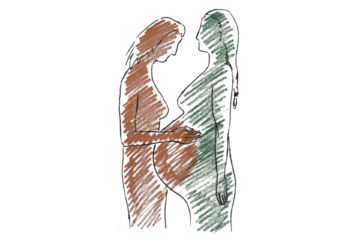In late August 2014, two national newspapers - the Daily Mail (1) and The Telegraph (2) - reported Human Fertilisation and Embryology Authority (HFEA) data showing that donations from nine sperm donors had produced 21 or more children each, while another six donors had produced 20 children (see BioNews 768).
These reports prompted two linked, but independent, Freedom of Information requests (3,4) by us to the HFEA. Subsequent email communication (5) also enquired about breaches of the 'ten family' limit introduced by the HFEA on 1 April 2006, and to what extent affected donors, recipients, and (where they were eligible) donor-conceived individuals had been advised of any breach.
The HFEA's response to our inquiries indicates a worrying policy confusion in which the potential interests of donors, recipients, and eligible donor-conceived individuals in learning information about donations that affect them may go unacknowledged.
While none of the 15 sperm donors mentioned in the media reports breached the ten family limit, the HFEA said it was aware of six breaches of this limit by other donors. It indicated that no affected parent or donor-conceived individual entitled to information by virtue of their age had been informed of the breach (4).
As regards informing donors, the HFEA provided conflicting information. We were first advised that, even though the HFEA had determined such breaches of the donor's consent to be a 'critical' area of non-compliance, it had not informed any affected donor. Ultimately, the HFEA considered the confidentiality risks too high to justify proactive contact and presumed that donors who do not enquire about the outcome of their donation may not wish to know (4). However, this runs counter to both HFEA policy and other information with which the HFEA provided us.
First, at its meeting on 7 December 2011, the HFEA decided:
'Should it come to light that a donor's gametes had been used to create more than ten families it would be incumbent upon the centre to inform the donor and families concerned' (our emphasis) (6).
The HFEA also informed us:
'A breach of the ten-family limit is treated as an "incident" by the Clinical Governance Team. In the process of investigating each such incident the team will be in regular correspondence with the centre or centres in question in order to satisfy themselves that any necessary procedural improvements have been put in place to minimise the risk of such occurrences happening again. During this correspondence the Clinical Governance team will request assurances that the donors in question are contacted' (5).
The HFEA failed to adequately explain how clinics were to notify donors or parents in the event that multiple clinics were involved.
A 2011 open letter from the chief executive says that, in the event of a family-limit breach, 'centres should contact the Register Information Team at the HFEA to check if a potential donor has registered recently at another clinic' (7). Email communication to us adds that 'at this time the centre can enquire as to the policy of informing affected donors in the event of a breach and if multiple centres are involved, they can inform them of the situation' (5).
To our mind the HFEA responses to our enquiries reveal a singular lack of coherence as regards breaches of its family-limit policy.
First, it appears that, rather than being proactive itself, the onus is on centres to enquire about the HFEA policy in relation to breaches. There is no reference at all in the HFEA Code of Practice to procedures to be followed in the event of a breach.
Second, inconsistency is evident regarding informing affected donors following a breach of the limit. The HFEA advised us that affected donors should be informed, but also that no affected donor had been informed; yet it also indicated satisfaction with compliance with its procedures.
Third, it is evident that by virtue of its specific reference to donors only, the HFEA has no policy of informing affected recipients or donor-conceived individuals, despite its recorded intention that 'families' should be informed.
Fourth, despite our best endeavours we have so far unable to ascertain exactly how the HFEA and clinics have responded to the actual breaches of the ten-family limit.
We recognise that breaches of the family limit and associated breaches of donor consent are rare events. Nevertheless, it is incumbent on the HFEA to clarify its policy as regards breaches. Given the contradictory information we have identified and, in order to remove any possibility of confusion, we suggest that at the point of donation and taking consent clinics should enquire under what circumstances both donors and recipients of donated gametes would wish to be contacted and given information.
Such circumstances could include breach of the family limit or adverse health outcomes affecting any offspring or donor that might have a genetic cause. As regards those who have already contacted the HFEA for information (for example, donor-conceived individuals over the age of 16, recipients of donor gametes and donors) it seems reasonable to assume that if they have already sought information, they would be interested in relevant updated information such as we have highlighted above.
However, in order to remove any possibility of ambiguity, we further suggest that when such information is first requested, the applicants could be given the option of registering their interest in being updated. These measures will ensure that no one is provided with unsolicited information that they do not actually want.
Further, we would endorse an even more proactive stance for individuals whose details are already on the HFEA Register. Since no donor would expect their gametes to be used in breach of HFEA rules or the conditions of their consent, we believe that proactive contact with donors is always justified and remain unconvinced that such contact could not be undertaken without breaching confidentiality. (As researchers we ourselves have made contact with former sperm donors whilst adhering to the stringent conditions for confidentiality required by an ethics committee (8, 9)).
Similarly, we believe that parents and donor-conceived adults, even if they have not sought further information from the HFEA, would not expect the family limit to be breached and should be told when this occurs.
Sources and References
-
4) F-2014-00254
-
5) Personal email communication
-
3) F-2014-00246
-
8) Crawshaw M, Blyth E and Daniels K. Past semen donors' views about the use of a voluntary contact register
-
9) Daniels K, Blyth E, Crawshaw M and Curson R. Previous semen donors and their views regarding the sharing of information with offspring
-
2) The 500 sperm donors who have 6,200 children between them
-
1) Britain's top 500 sperm donors have fathered more than 6,000 children between them - and some have TWENTY children each
-
6) Minutes of Authority meeting 07 December 2011
-
7) Chief executive's letter: CE(11)02 - Donation Review: Preparing for implementation






Leave a Reply
You must be logged in to post a comment.